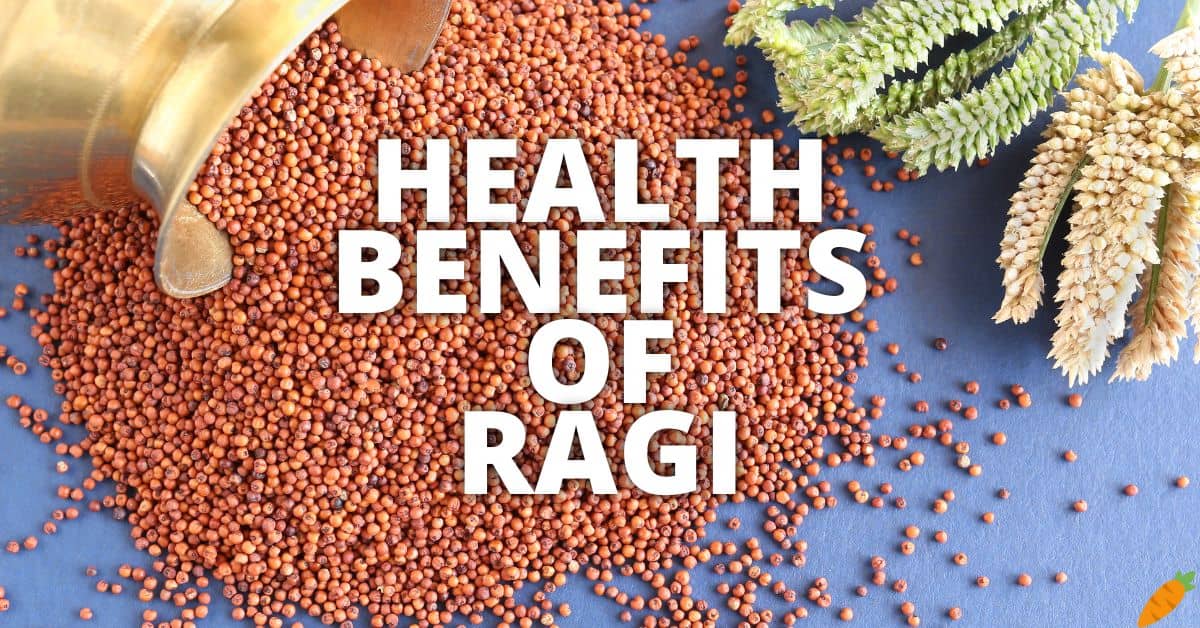It’s a good day to learn about the potential health benefits of ragi.
🤔 What is Ragi?
Ragi, also known as finger millet, is a cereal grain that originates from Africa and has been cultivated in India for thousands of years.
It is a hardy crop that grows well in arid and semi-arid regions.
Ragi grains are a rich source of protein, dietary fiber, and essential minerals like calcium and iron.
It’s commonly consumed as a staple in various forms, such as flatbreads, porridge, and fermented beverages.
Due to its nutritional profile, Ragi is often recommended as a wholesome food for infants, diabetics, and those seeking gluten-free options.
📝 Here’s a list of the potential health benefits of ragi.
- High In Calcium
- Abundant Dietary Fiber
- Beneficial For Diabetics
- Loaded With Iron
- Free From Gluten
- Acts As A Relaxant
- Reduces Harmful Cholesterol
- Full Of Antioxidants
- Boosts Skin Well-Being
- Supports Weight Management
- Enhances Lactation
Please keep reading if you want to learn more.
1. Rich In Calcium
Ragi stands out as one of the best natural sources of calcium among grains.
Calcium is vital for maintaining the strength and density of bones and teeth.
Regular consumption of ragi can be particularly beneficial for growing children and post-menopausal women, as they require higher calcium intake.
This mineral also plays a role in muscle function and nerve transmission.
Therefore, incorporating ragi into one’s diet can contribute to overall skeletal health and prevent conditions like osteoporosis.
2. High Dietary Fiber
Ragi is packed with dietary fiber, making it an excellent choice for digestive health.
This fiber helps smooth bowel movements and prevents constipation.
When consumed, foods rich in fiber, like ragi, can make you feel full faster, reducing the likelihood of overeating.
This feeling of fullness can be especially beneficial for those looking to manage or lose weight.
Additionally, a diet high in fiber can help stabilize blood sugar levels, reducing sudden spikes or drops.
3. Good For Diabetics
Ragi has a low glycemic index (GI), which means it releases sugar into the bloodstream at a slower rate.
This gradual release is crucial for diabetics, as it prevents sudden spikes in blood sugar levels.
Consuming foods with a low GI, like ragi, allows for better blood sugar management.
Regular inclusion of ragi in the diet can aid in maintaining consistent energy levels without causing drastic changes in insulin needs.
As a result, ragi is often recommended as a staple for those looking to manage or prevent diabetes.
4. Rich In Iron
Ragi is a noteworthy source of iron, a mineral essential for the formation of red blood cells.
Adequate iron intake ensures optimal oxygen transport throughout the body, promoting overall vitality.
When consumed regularly, ragi can assist in combating iron-deficiency anemia, a condition where reduced hemoglobin leads to fatigue and weakness.
Including ragi in the diet can boost hemoglobin levels, enhancing the blood’s capacity to carry oxygen.
This makes ragi an excellent dietary choice for those at risk of anemia or looking to improve their iron intake.
📚 Finger Millet (Ragi) As An Essential Dietary Supplement With Key Health Benefits: A Review
5. Gluten-Free
Ragi does not contain gluten, a protein found in wheat, barley, and rye.
This makes it a safe and nutritious option for individuals who are sensitive to gluten or suffer from conditions like celiac disease.
Celiac disease is an autoimmune disorder where gluten intake can damage the small intestine.
For such individuals, consuming gluten-free grains like ragi can prevent digestive issues and nutrient malabsorption.
As a result, ragi offers a beneficial dietary alternative without compromising on essential nutrients or taste.
6. Natural Relaxant
Ragi boasts a rich profile of amino acids, including tryptophan, known for its calming effects on the human body.
Tryptophan plays a pivotal role in the production of serotonin, a neurotransmitter associated with mood regulation and relaxation.
Increased serotonin levels can aid in alleviating symptoms of anxiety and depression, promoting a sense of well-being.
Furthermore, by influencing sleep patterns, tryptophan can be beneficial in managing insomnia, helping individuals achieve restful sleep.
Thus, consuming ragi might support mental well-being by naturally regulating mood and sleep cycles.
7. Lowers Bad Cholesterol
Ragi possesses components that actively contribute to reducing “bad” cholesterol in the body.
High levels of bad cholesterol, or LDL, can lead to plaque buildup in the arteries, increasing the risk of heart disease.
By lowering triglycerides and LDL cholesterol levels, ragi promotes healthier arteries and better blood circulation.
Regular consumption of ragi can serve as a preventive measure against conditions like atherosclerosis, where arteries harden due to cholesterol deposits.
Thus, integrating ragi into one’s diet can be beneficial for maintaining heart health and reducing cardiovascular risks.
8. Rich In Antioxidants (My Favorite Potential Health Benefit Of Ragi) ⭐️
Ragi is a treasure trove of antioxidants, thanks to its rich content of phenolic compounds and phytochemicals.
Antioxidants play a crucial role in neutralizing harmful free radicals in the body.
These free radicals, if unchecked, can cause oxidative stress, leading to cell damage and aging.
By combating oxidative stress, the antioxidants in ragi help maintain cell health and reduce the risk of chronic diseases.
As such, consuming ragi can contribute to better overall health, longevity, and protection against age-related ailments.
9. Promotes Skin Health
Ragi is enriched with vital amino acids such as methionine and lysine, which play pivotal roles in skin and hair health.
Methionine aids in the formation of collagen and elastin, both essential for maintaining skin’s elasticity and youthful appearance.
Lysine, on the other hand, assists in hair growth, strength, and repair.
Together, these amino acids ensure that the skin remains supple and radiant while also promoting lustrous hair.
Incorporating ragi into one’s diet can, therefore, offer a natural boost to both skin vitality and hair health.
📚 Nutritional Composition & Anti-Nutritional Content Of Ragi Based Amylase Rich Premixes
10. Helps In Weight Loss
Ragi is a fiber-rich grain, making it a prime choice for those focusing on weight loss.
The high fiber content in ragi aids in slowing digestion, resulting in prolonged feelings of fullness and reduced hunger pangs.
This can lead to decreased overall calorie intake, facilitating weight loss.
Moreover, the complex carbohydrates in ragi release energy slowly, ensuring consistent energy levels without unwanted calorie spikes.
By incorporating ragi into regular meals, one can support their weight loss journey while also benefiting from its myriad other health attributes.
11. Aids Lactation
Ragi is considered a galactagogue, meaning it can potentially stimulate milk production in lactating mothers.
The presence of essential amino acids and minerals in ragi plays a role in enhancing the quality and quantity of breast milk.
Additionally, the rich calcium content in ragi can be transferred through the milk, benefiting both the mother and the infant.
By consuming ragi, lactating mothers can ensure that their milk is nutrient-dense, supporting the baby’s growth and development.
Hence, incorporating ragi into a nursing mother’s diet can be advantageous for both maternal and infant health.
💡 Conclusion
Ragi emerges as a powerhouse grain with a plethora of health benefits.
From fortifying bones with its rich calcium content to aiding weight loss through its high dietary fiber, its merits are multifaceted.
Individuals with gluten intolerance can find a safe haven in ragi, while those managing diabetes can benefit from its low glycemic index.
Furthermore, its nutrient-rich profile makes it a favorable choice for nursing mothers and those keen on enhancing skin and hair health.
Indeed, the humble ragi grain stands as a testament to nature’s ability to pack incredible health benefits into small packages.
😊 My favorite potential health benefit of ragi is that it may be rich in antioxidants.
I like knowing about foods that are good sources of antioxidants.
They’re good things to have to reduce our risk of chronic diseases.
What’s your favorite potential health benefit of ragi?
😎 You can also read posts about the potential health benefits of other grains here.
If you find this post interesting, please share it with your family and friends.
I appreciate it!
Be healthy 💪 and stay safe 🦺!
⛑️ Safety First
While ragi offers a myriad of potential health benefits, it’s essential to approach its consumption with caution.
Individuals with specific health conditions or allergies should consult with a doctor before integrating ragi into their diet.
Some of these touted benefits may be based on anecdotal evidence, so it’s crucial to differentiate between proven facts and personal experiences.
Always conduct thorough research and seek professional guidance when considering any dietary changes.
Remember, what works for one might not necessarily work for another, and personalized advice is invaluable.
📋 Summary
| Potential Health Benefits Of Ragi | Details |
| Rich In Calcium | Essential for strengthening bones and teeth. |
| High Dietary Fiber | Aids in digestion and provides a feeling of fullness, which can prevent overeating. |
| Good For Diabetics | Due to its low glycemic index, it helps control blood sugar levels. |
| Rich In Iron | Can help prevent anemia and improve hemoglobin levels in the body. |
| Gluten-Free | An ideal grain choice for those with gluten intolerance or celiac disease. |
| Natural Relaxant | Contains amino acids, like tryptophan, that help combat anxiety and insomnia. |
| Lowers Bad Cholesterol | Assists in reducing levels of triglycerides, promoting heart health. |
| Rich In Antioxidants | Contains phenolic compounds and phytochemicals that combat oxidative stress. |
| Promotes Skin Health | Has amino acids, such as methionine and lysine, that enhance skin vitality. |
| Helps In Weight Loss | Its high dietary fiber content can support weight management efforts. |
| Aids Lactation | Often recommended for lactating mothers to improve milk production and its nutrient quality. |
⚠️ Content Disclaimer
This content is provided for informational purposes only and is not intended as medical or professional advice.
While every effort has been made to ensure accuracy, the author and publisher cannot guarantee its correctness or completeness.
Readers are encouraged to consult with qualified professionals before making any decisions based on this material.
The views and opinions expressed may not reflect those of the publisher or any affiliated parties.
Use of this content is at the reader’s own risk and discretion.

